Business Economics Assignment - Microeconomics Analysis, Part A
VerifiedAdded on 2020/05/28
|14
|1935
|115
Homework Assignment
AI Summary
This business economics assignment delves into microeconomic principles, providing detailed answers to various questions. It begins by defining external costs and benefits and discussing the characteristics of public goods. The assignment then analyzes cost structures, including total, average, and marginal costs, for firms operating under imperfect competition. It explores the differences between fixed and variable inputs and their impact on production costs. The core of the assignment examines perfect competition, defining its characteristics, and analyzing short-run and long-run equilibrium conditions for firms and industries. The assignment also includes analysis of how changes in the prices of related goods, such as substitutes and complements, affect market equilibrium, and how taxes and technological advancements influence market dynamics. The solutions are comprehensive, providing a thorough understanding of microeconomic concepts and their application in business contexts.
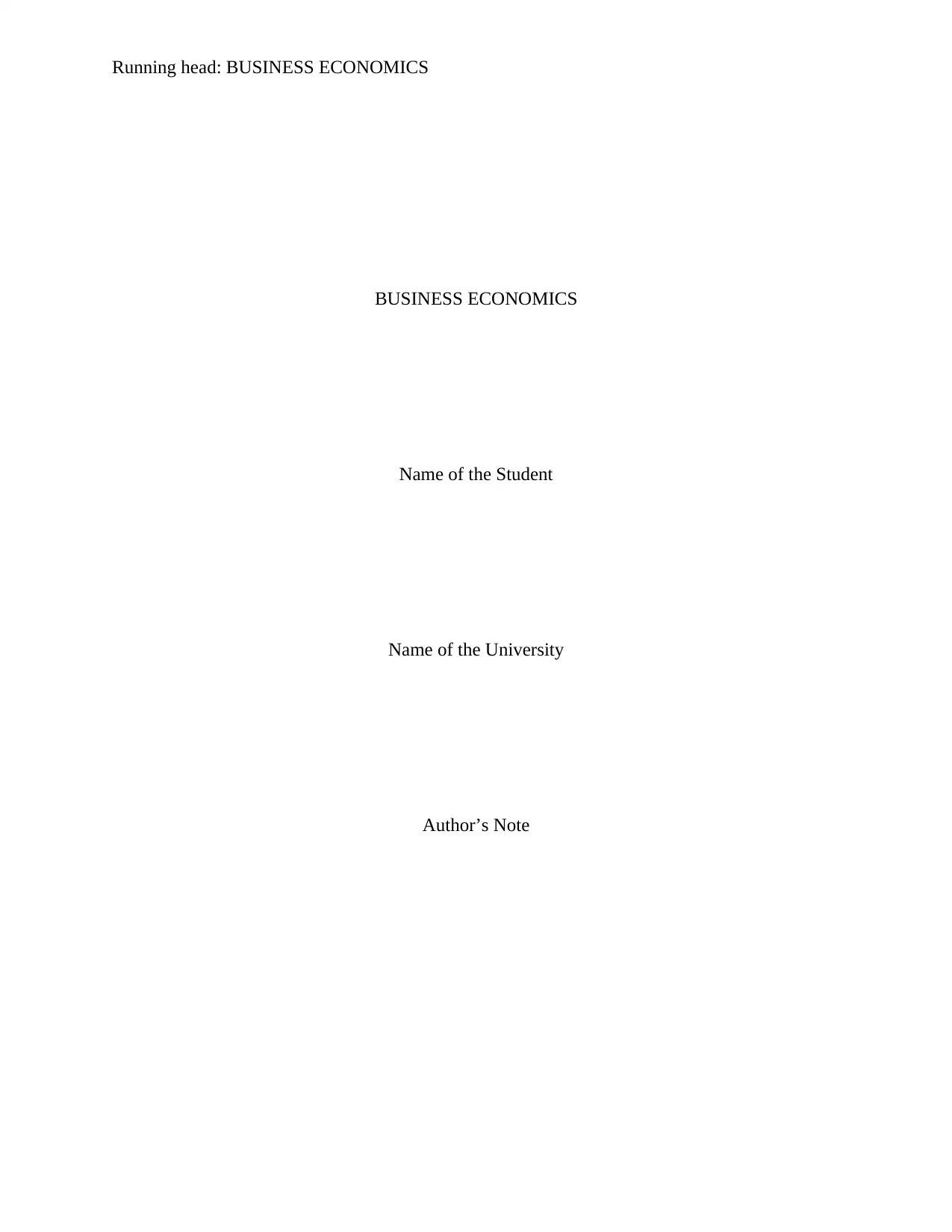
Running head: BUSINESS ECONOMICS
BUSINESS ECONOMICS
Name of the Student
Name of the University
Author’s Note
BUSINESS ECONOMICS
Name of the Student
Name of the University
Author’s Note
Paraphrase This Document
Need a fresh take? Get an instant paraphrase of this document with our AI Paraphraser
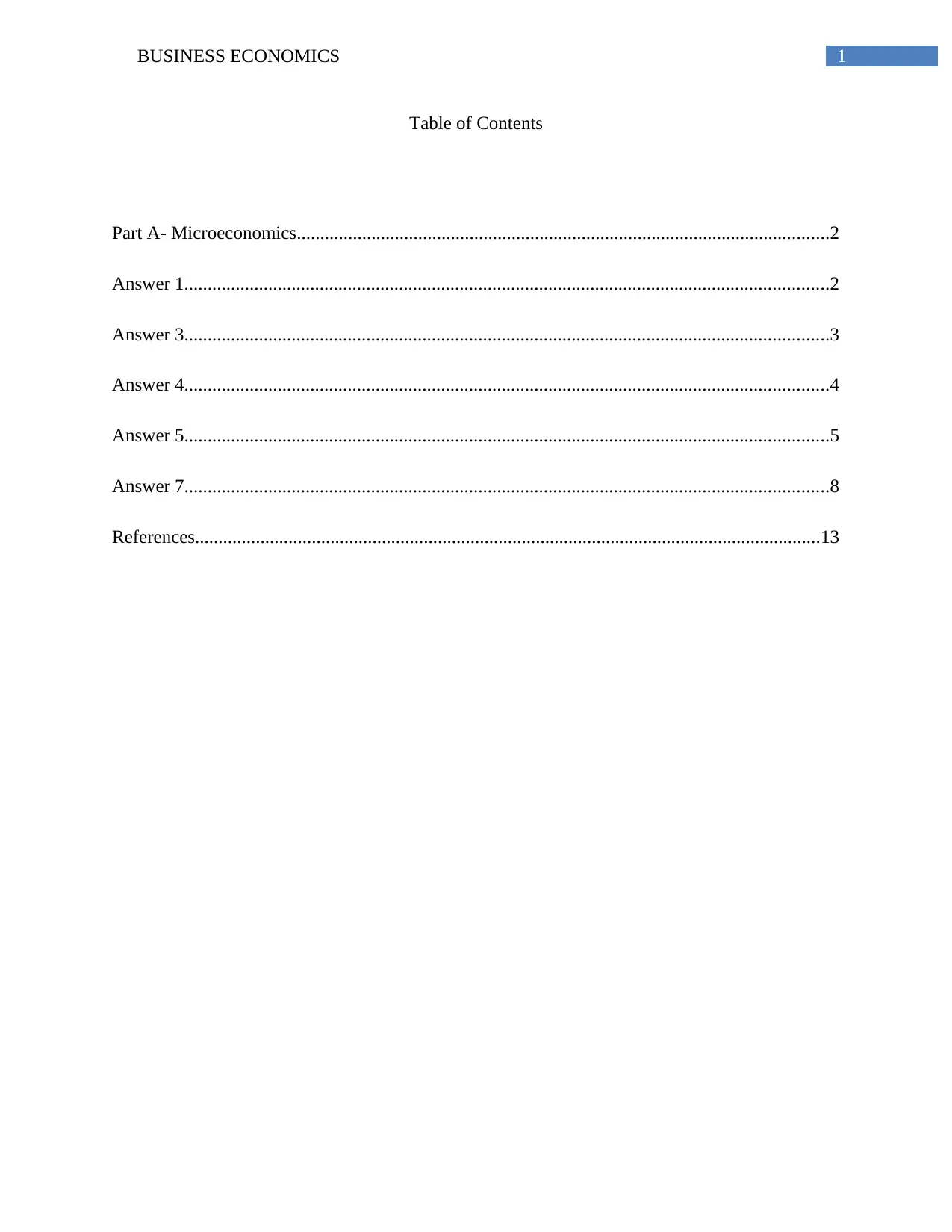
1BUSINESS ECONOMICS
Table of Contents
Part A- Microeconomics..................................................................................................................2
Answer 1..........................................................................................................................................2
Answer 3..........................................................................................................................................3
Answer 4..........................................................................................................................................4
Answer 5..........................................................................................................................................5
Answer 7..........................................................................................................................................8
References......................................................................................................................................13
Table of Contents
Part A- Microeconomics..................................................................................................................2
Answer 1..........................................................................................................................................2
Answer 3..........................................................................................................................................3
Answer 4..........................................................................................................................................4
Answer 5..........................................................................................................................................5
Answer 7..........................................................................................................................................8
References......................................................................................................................................13
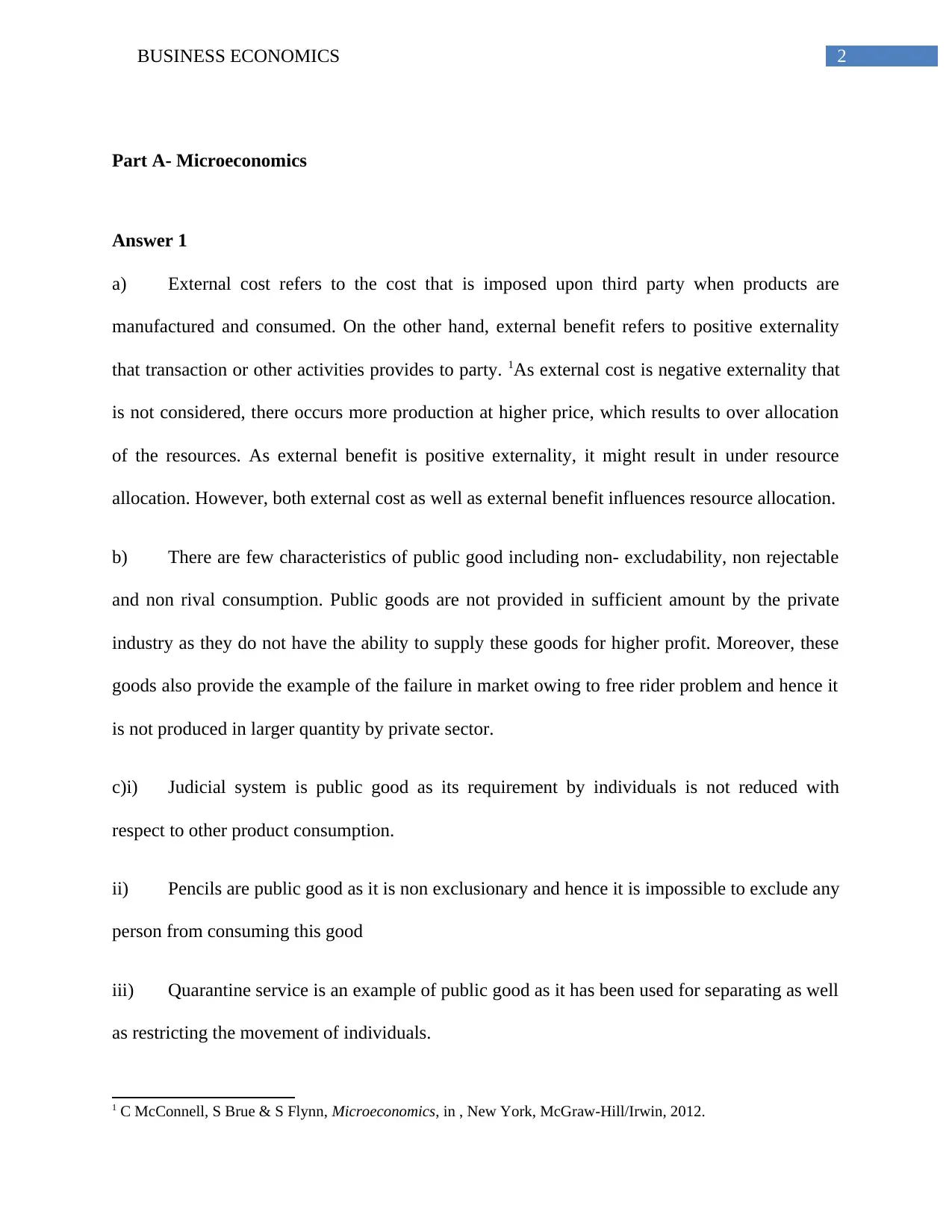
2BUSINESS ECONOMICS
Part A- Microeconomics
Answer 1
a) External cost refers to the cost that is imposed upon third party when products are
manufactured and consumed. On the other hand, external benefit refers to positive externality
that transaction or other activities provides to party. 1As external cost is negative externality that
is not considered, there occurs more production at higher price, which results to over allocation
of the resources. As external benefit is positive externality, it might result in under resource
allocation. However, both external cost as well as external benefit influences resource allocation.
b) There are few characteristics of public good including non- excludability, non rejectable
and non rival consumption. Public goods are not provided in sufficient amount by the private
industry as they do not have the ability to supply these goods for higher profit. Moreover, these
goods also provide the example of the failure in market owing to free rider problem and hence it
is not produced in larger quantity by private sector.
c)i) Judicial system is public good as its requirement by individuals is not reduced with
respect to other product consumption.
ii) Pencils are public good as it is non exclusionary and hence it is impossible to exclude any
person from consuming this good
iii) Quarantine service is an example of public good as it has been used for separating as well
as restricting the movement of individuals.
1 C McConnell, S Brue & S Flynn, Microeconomics, in , New York, McGraw-Hill/Irwin, 2012.
Part A- Microeconomics
Answer 1
a) External cost refers to the cost that is imposed upon third party when products are
manufactured and consumed. On the other hand, external benefit refers to positive externality
that transaction or other activities provides to party. 1As external cost is negative externality that
is not considered, there occurs more production at higher price, which results to over allocation
of the resources. As external benefit is positive externality, it might result in under resource
allocation. However, both external cost as well as external benefit influences resource allocation.
b) There are few characteristics of public good including non- excludability, non rejectable
and non rival consumption. Public goods are not provided in sufficient amount by the private
industry as they do not have the ability to supply these goods for higher profit. Moreover, these
goods also provide the example of the failure in market owing to free rider problem and hence it
is not produced in larger quantity by private sector.
c)i) Judicial system is public good as its requirement by individuals is not reduced with
respect to other product consumption.
ii) Pencils are public good as it is non exclusionary and hence it is impossible to exclude any
person from consuming this good
iii) Quarantine service is an example of public good as it has been used for separating as well
as restricting the movement of individuals.
1 C McConnell, S Brue & S Flynn, Microeconomics, in , New York, McGraw-Hill/Irwin, 2012.
⊘ This is a preview!⊘
Do you want full access?
Subscribe today to unlock all pages.

Trusted by 1+ million students worldwide
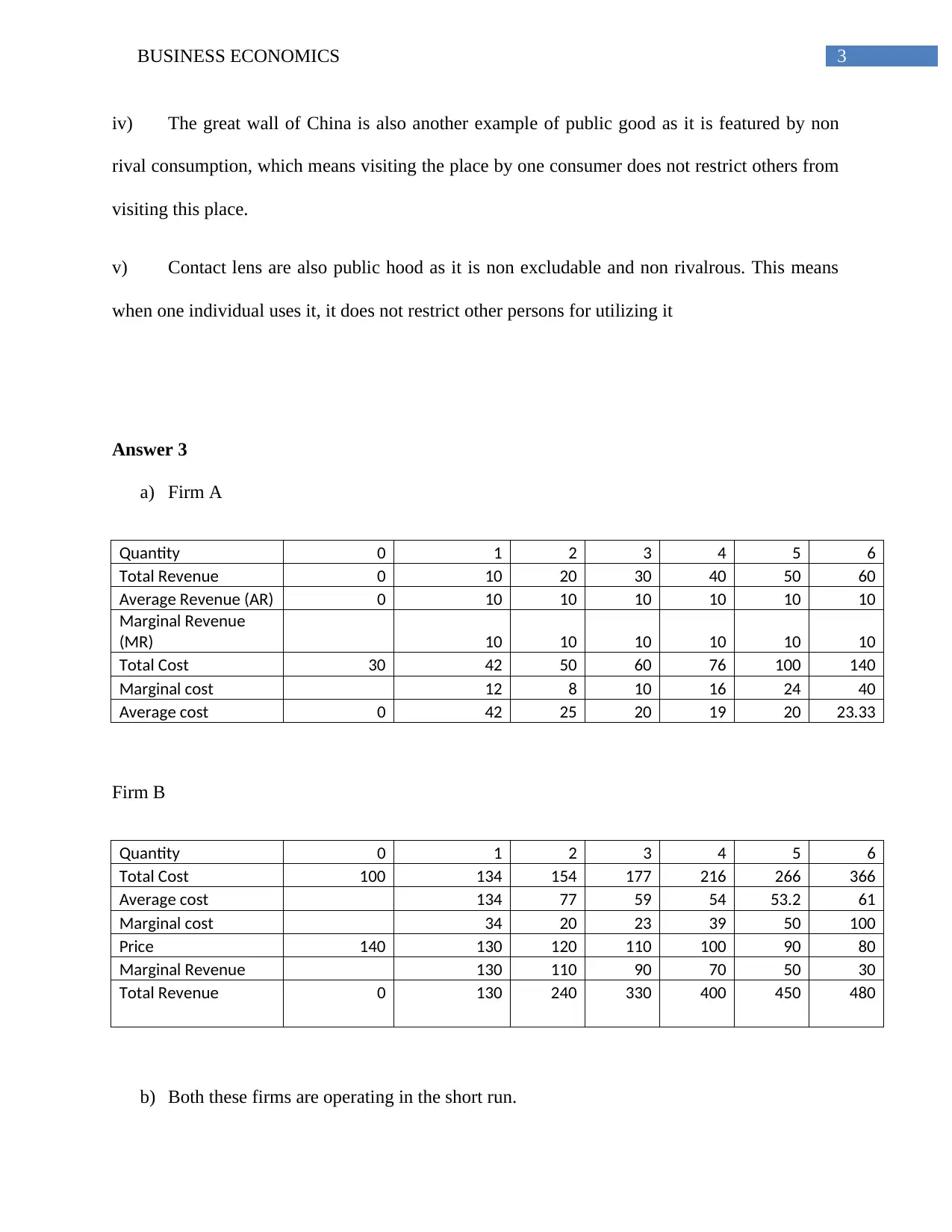
3BUSINESS ECONOMICS
iv) The great wall of China is also another example of public good as it is featured by non
rival consumption, which means visiting the place by one consumer does not restrict others from
visiting this place.
v) Contact lens are also public hood as it is non excludable and non rivalrous. This means
when one individual uses it, it does not restrict other persons for utilizing it
Answer 3
a) Firm A
Quantity 0 1 2 3 4 5 6
Total Revenue 0 10 20 30 40 50 60
Average Revenue (AR) 0 10 10 10 10 10 10
Marginal Revenue
(MR) 10 10 10 10 10 10
Total Cost 30 42 50 60 76 100 140
Marginal cost 12 8 10 16 24 40
Average cost 0 42 25 20 19 20 23.33
Firm B
Quantity 0 1 2 3 4 5 6
Total Cost 100 134 154 177 216 266 366
Average cost 134 77 59 54 53.2 61
Marginal cost 34 20 23 39 50 100
Price 140 130 120 110 100 90 80
Marginal Revenue 130 110 90 70 50 30
Total Revenue 0 130 240 330 400 450 480
b) Both these firms are operating in the short run.
iv) The great wall of China is also another example of public good as it is featured by non
rival consumption, which means visiting the place by one consumer does not restrict others from
visiting this place.
v) Contact lens are also public hood as it is non excludable and non rivalrous. This means
when one individual uses it, it does not restrict other persons for utilizing it
Answer 3
a) Firm A
Quantity 0 1 2 3 4 5 6
Total Revenue 0 10 20 30 40 50 60
Average Revenue (AR) 0 10 10 10 10 10 10
Marginal Revenue
(MR) 10 10 10 10 10 10
Total Cost 30 42 50 60 76 100 140
Marginal cost 12 8 10 16 24 40
Average cost 0 42 25 20 19 20 23.33
Firm B
Quantity 0 1 2 3 4 5 6
Total Cost 100 134 154 177 216 266 366
Average cost 134 77 59 54 53.2 61
Marginal cost 34 20 23 39 50 100
Price 140 130 120 110 100 90 80
Marginal Revenue 130 110 90 70 50 30
Total Revenue 0 130 240 330 400 450 480
b) Both these firms are operating in the short run.
Paraphrase This Document
Need a fresh take? Get an instant paraphrase of this document with our AI Paraphraser
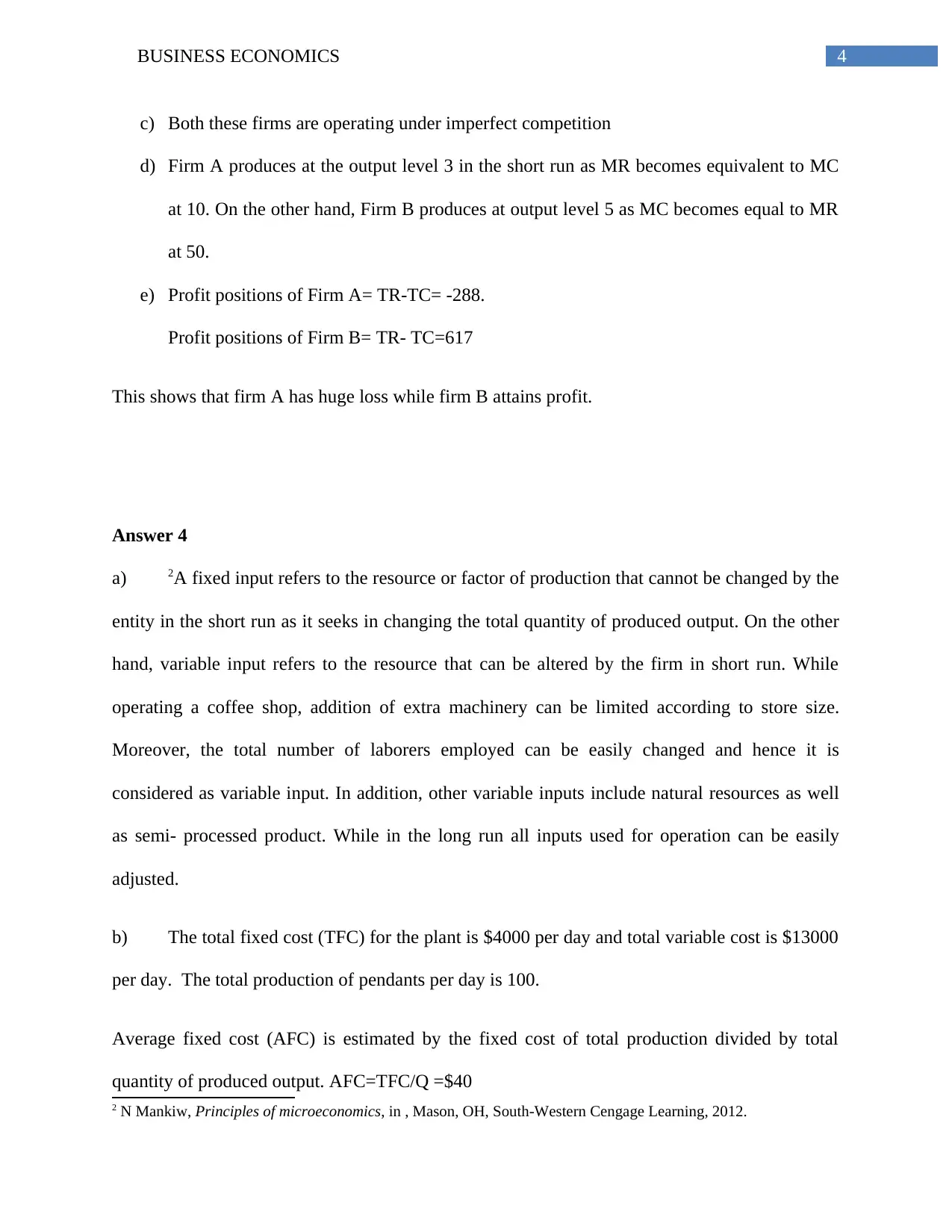
4BUSINESS ECONOMICS
c) Both these firms are operating under imperfect competition
d) Firm A produces at the output level 3 in the short run as MR becomes equivalent to MC
at 10. On the other hand, Firm B produces at output level 5 as MC becomes equal to MR
at 50.
e) Profit positions of Firm A= TR-TC= -288.
Profit positions of Firm B= TR- TC=617
This shows that firm A has huge loss while firm B attains profit.
Answer 4
a) 2A fixed input refers to the resource or factor of production that cannot be changed by the
entity in the short run as it seeks in changing the total quantity of produced output. On the other
hand, variable input refers to the resource that can be altered by the firm in short run. While
operating a coffee shop, addition of extra machinery can be limited according to store size.
Moreover, the total number of laborers employed can be easily changed and hence it is
considered as variable input. In addition, other variable inputs include natural resources as well
as semi- processed product. While in the long run all inputs used for operation can be easily
adjusted.
b) The total fixed cost (TFC) for the plant is $4000 per day and total variable cost is $13000
per day. The total production of pendants per day is 100.
Average fixed cost (AFC) is estimated by the fixed cost of total production divided by total
quantity of produced output. AFC=TFC/Q =$40
2 N Mankiw, Principles of microeconomics, in , Mason, OH, South-Western Cengage Learning, 2012.
c) Both these firms are operating under imperfect competition
d) Firm A produces at the output level 3 in the short run as MR becomes equivalent to MC
at 10. On the other hand, Firm B produces at output level 5 as MC becomes equal to MR
at 50.
e) Profit positions of Firm A= TR-TC= -288.
Profit positions of Firm B= TR- TC=617
This shows that firm A has huge loss while firm B attains profit.
Answer 4
a) 2A fixed input refers to the resource or factor of production that cannot be changed by the
entity in the short run as it seeks in changing the total quantity of produced output. On the other
hand, variable input refers to the resource that can be altered by the firm in short run. While
operating a coffee shop, addition of extra machinery can be limited according to store size.
Moreover, the total number of laborers employed can be easily changed and hence it is
considered as variable input. In addition, other variable inputs include natural resources as well
as semi- processed product. While in the long run all inputs used for operation can be easily
adjusted.
b) The total fixed cost (TFC) for the plant is $4000 per day and total variable cost is $13000
per day. The total production of pendants per day is 100.
Average fixed cost (AFC) is estimated by the fixed cost of total production divided by total
quantity of produced output. AFC=TFC/Q =$40
2 N Mankiw, Principles of microeconomics, in , Mason, OH, South-Western Cengage Learning, 2012.
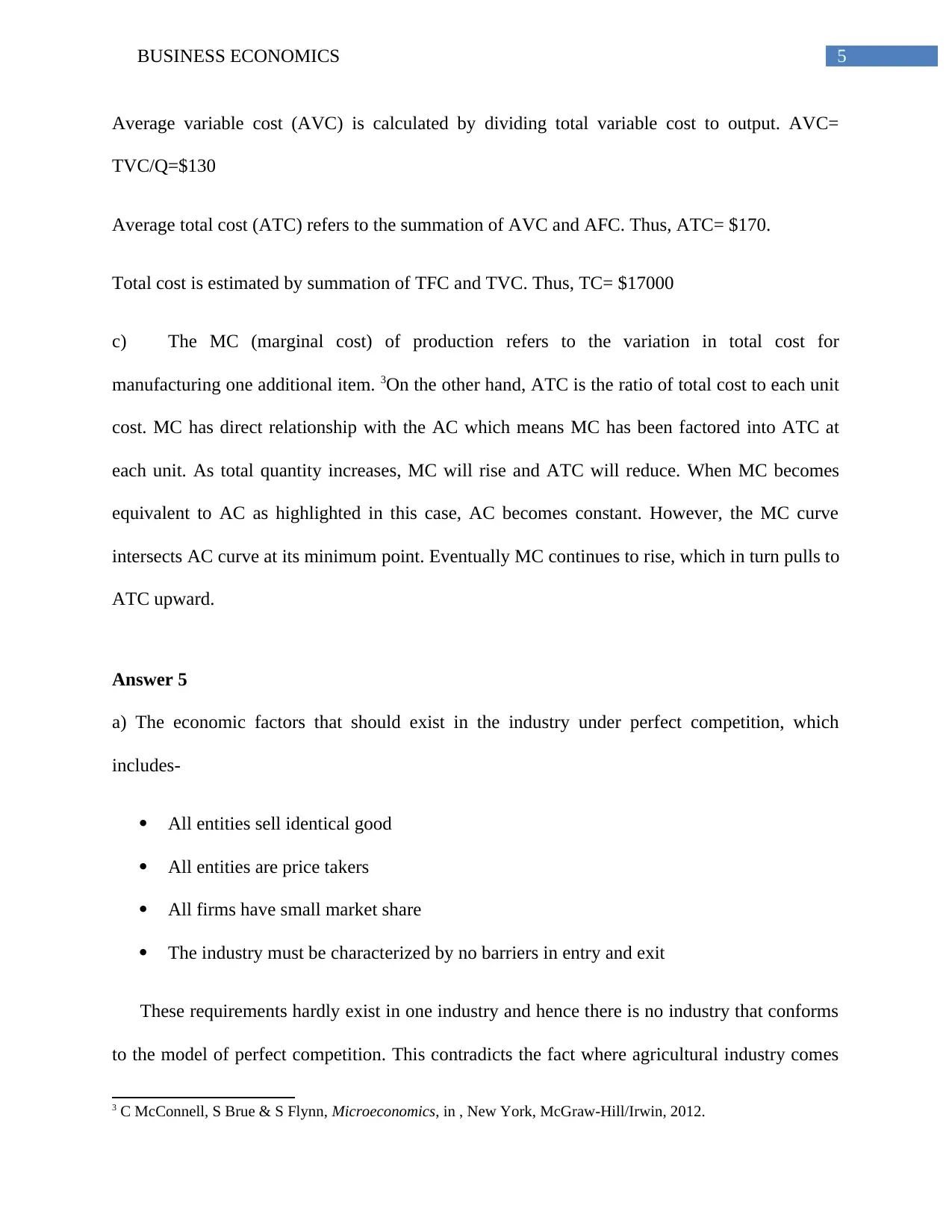
5BUSINESS ECONOMICS
Average variable cost (AVC) is calculated by dividing total variable cost to output. AVC=
TVC/Q=$130
Average total cost (ATC) refers to the summation of AVC and AFC. Thus, ATC= $170.
Total cost is estimated by summation of TFC and TVC. Thus, TC= $17000
c) The MC (marginal cost) of production refers to the variation in total cost for
manufacturing one additional item. 3On the other hand, ATC is the ratio of total cost to each unit
cost. MC has direct relationship with the AC which means MC has been factored into ATC at
each unit. As total quantity increases, MC will rise and ATC will reduce. When MC becomes
equivalent to AC as highlighted in this case, AC becomes constant. However, the MC curve
intersects AC curve at its minimum point. Eventually MC continues to rise, which in turn pulls to
ATC upward.
Answer 5
a) The economic factors that should exist in the industry under perfect competition, which
includes-
All entities sell identical good
All entities are price takers
All firms have small market share
The industry must be characterized by no barriers in entry and exit
These requirements hardly exist in one industry and hence there is no industry that conforms
to the model of perfect competition. This contradicts the fact where agricultural industry comes
3 C McConnell, S Brue & S Flynn, Microeconomics, in , New York, McGraw-Hill/Irwin, 2012.
Average variable cost (AVC) is calculated by dividing total variable cost to output. AVC=
TVC/Q=$130
Average total cost (ATC) refers to the summation of AVC and AFC. Thus, ATC= $170.
Total cost is estimated by summation of TFC and TVC. Thus, TC= $17000
c) The MC (marginal cost) of production refers to the variation in total cost for
manufacturing one additional item. 3On the other hand, ATC is the ratio of total cost to each unit
cost. MC has direct relationship with the AC which means MC has been factored into ATC at
each unit. As total quantity increases, MC will rise and ATC will reduce. When MC becomes
equivalent to AC as highlighted in this case, AC becomes constant. However, the MC curve
intersects AC curve at its minimum point. Eventually MC continues to rise, which in turn pulls to
ATC upward.
Answer 5
a) The economic factors that should exist in the industry under perfect competition, which
includes-
All entities sell identical good
All entities are price takers
All firms have small market share
The industry must be characterized by no barriers in entry and exit
These requirements hardly exist in one industry and hence there is no industry that conforms
to the model of perfect competition. This contradicts the fact where agricultural industry comes
3 C McConnell, S Brue & S Flynn, Microeconomics, in , New York, McGraw-Hill/Irwin, 2012.
⊘ This is a preview!⊘
Do you want full access?
Subscribe today to unlock all pages.

Trusted by 1+ million students worldwide
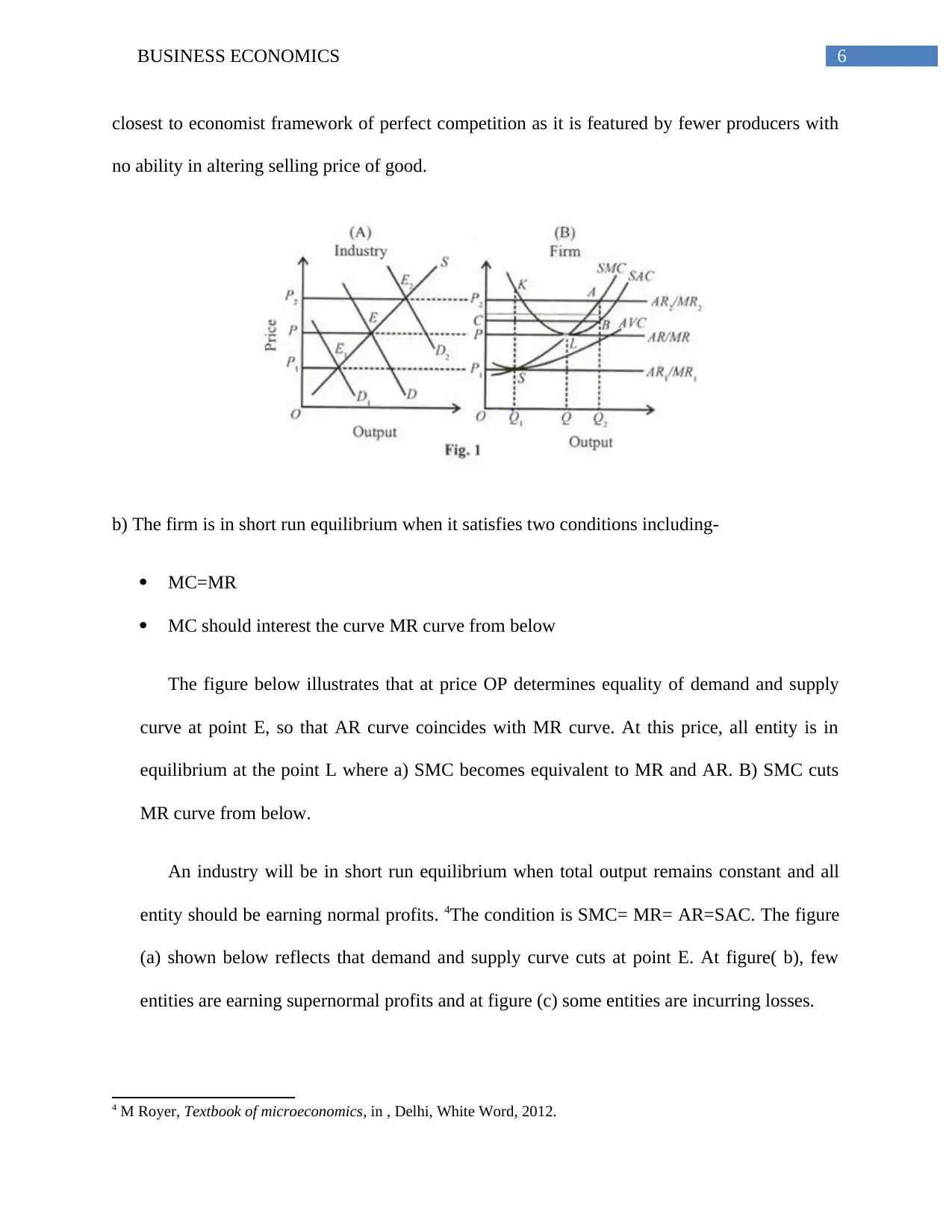
6BUSINESS ECONOMICS
closest to economist framework of perfect competition as it is featured by fewer producers with
no ability in altering selling price of good.
b) The firm is in short run equilibrium when it satisfies two conditions including-
MC=MR
MC should interest the curve MR curve from below
The figure below illustrates that at price OP determines equality of demand and supply
curve at point E, so that AR curve coincides with MR curve. At this price, all entity is in
equilibrium at the point L where a) SMC becomes equivalent to MR and AR. B) SMC cuts
MR curve from below.
An industry will be in short run equilibrium when total output remains constant and all
entity should be earning normal profits. 4The condition is SMC= MR= AR=SAC. The figure
(a) shown below reflects that demand and supply curve cuts at point E. At figure( b), few
entities are earning supernormal profits and at figure (c) some entities are incurring losses.
4 M Royer, Textbook of microeconomics, in , Delhi, White Word, 2012.
closest to economist framework of perfect competition as it is featured by fewer producers with
no ability in altering selling price of good.
b) The firm is in short run equilibrium when it satisfies two conditions including-
MC=MR
MC should interest the curve MR curve from below
The figure below illustrates that at price OP determines equality of demand and supply
curve at point E, so that AR curve coincides with MR curve. At this price, all entity is in
equilibrium at the point L where a) SMC becomes equivalent to MR and AR. B) SMC cuts
MR curve from below.
An industry will be in short run equilibrium when total output remains constant and all
entity should be earning normal profits. 4The condition is SMC= MR= AR=SAC. The figure
(a) shown below reflects that demand and supply curve cuts at point E. At figure( b), few
entities are earning supernormal profits and at figure (c) some entities are incurring losses.
4 M Royer, Textbook of microeconomics, in , Delhi, White Word, 2012.
Paraphrase This Document
Need a fresh take? Get an instant paraphrase of this document with our AI Paraphraser

7BUSINESS ECONOMICS
Figure 1: short run perfectively competitive eqauilibrium
c) The entity is in long run perfectly competitive equilibrium can raise its output by varying
their capital equipment. Moreover, new entity enters the sector for competing with the existing
entities. The figure below shows that the entity cannot be in equilibrium if price is larger than
OP. Similarly, the entity cannot be in equilibrium at price less than OP. Moreover, the AR and
MR curve must lie below AC curve, such that P=MR. However, some entity in this industry
moves out as price rises and hence existing firm makes normal profit. The entities continue to
leave the industry until P becomes equivalent to AC, such that firms make normal profit. 5The
condition for long run profit maximization is LMC=SMC = MR. This is shown in figure below:
5 D Nomidis, "A Reconsideration of the Theory of Perfect Competition", in SSRN Electronic Journal, , 2015.
Figure 1: short run perfectively competitive eqauilibrium
c) The entity is in long run perfectly competitive equilibrium can raise its output by varying
their capital equipment. Moreover, new entity enters the sector for competing with the existing
entities. The figure below shows that the entity cannot be in equilibrium if price is larger than
OP. Similarly, the entity cannot be in equilibrium at price less than OP. Moreover, the AR and
MR curve must lie below AC curve, such that P=MR. However, some entity in this industry
moves out as price rises and hence existing firm makes normal profit. The entities continue to
leave the industry until P becomes equivalent to AC, such that firms make normal profit. 5The
condition for long run profit maximization is LMC=SMC = MR. This is shown in figure below:
5 D Nomidis, "A Reconsideration of the Theory of Perfect Competition", in SSRN Electronic Journal, , 2015.
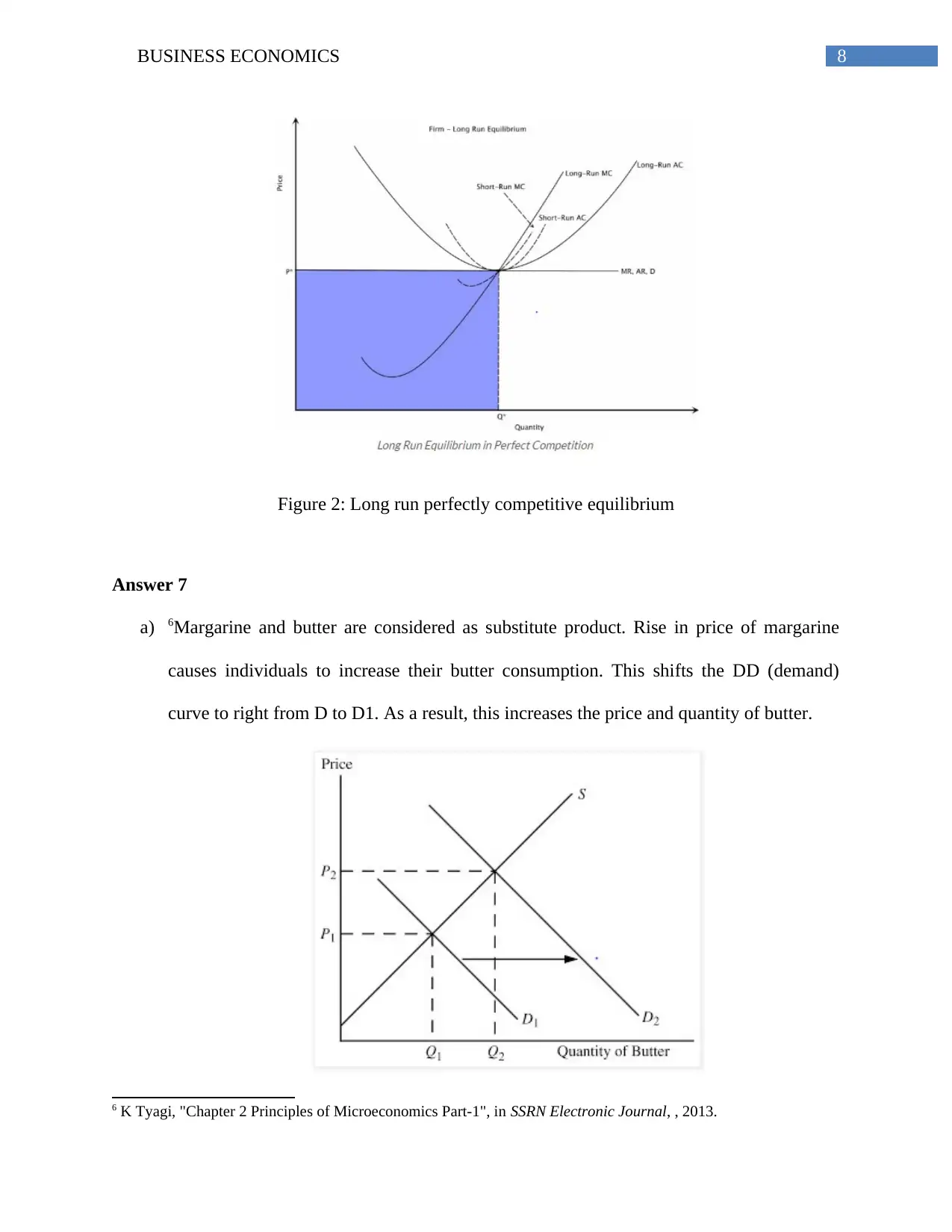
8BUSINESS ECONOMICS
Figure 2: Long run perfectly competitive equilibrium
Answer 7
a) 6Margarine and butter are considered as substitute product. Rise in price of margarine
causes individuals to increase their butter consumption. This shifts the DD (demand)
curve to right from D to D1. As a result, this increases the price and quantity of butter.
6 K Tyagi, "Chapter 2 Principles of Microeconomics Part-1", in SSRN Electronic Journal, , 2013.
Figure 2: Long run perfectly competitive equilibrium
Answer 7
a) 6Margarine and butter are considered as substitute product. Rise in price of margarine
causes individuals to increase their butter consumption. This shifts the DD (demand)
curve to right from D to D1. As a result, this increases the price and quantity of butter.
6 K Tyagi, "Chapter 2 Principles of Microeconomics Part-1", in SSRN Electronic Journal, , 2013.
⊘ This is a preview!⊘
Do you want full access?
Subscribe today to unlock all pages.

Trusted by 1+ million students worldwide

9BUSINESS ECONOMICS
Quantity of butter
S
S1
D
P
P1
Q Q1
Quantity of butter
Price S
D
D
D1
D1
Q1 Q
P
P1
Figure a
b) As butter and yoghurt are jointly supplied, rise in price of yoghurt shifts the supply curve
to right from SS to SS1. As a result, price of butter declines and its quantity rises.
Figure b
c) As bread and butter are complementary product, rise in price of bread leads decline in
consumption of butter. This shifts the demand curve to left from DD to DD1. However,
both price and quantity of butter falls.
Figure c
Price
Quantity of butter
S
S1
D
P
P1
Q Q1
Quantity of butter
Price S
D
D
D1
D1
Q1 Q
P
P1
Figure a
b) As butter and yoghurt are jointly supplied, rise in price of yoghurt shifts the supply curve
to right from SS to SS1. As a result, price of butter declines and its quantity rises.
Figure b
c) As bread and butter are complementary product, rise in price of bread leads decline in
consumption of butter. This shifts the demand curve to left from DD to DD1. However,
both price and quantity of butter falls.
Figure c
Price
Paraphrase This Document
Need a fresh take? Get an instant paraphrase of this document with our AI Paraphraser
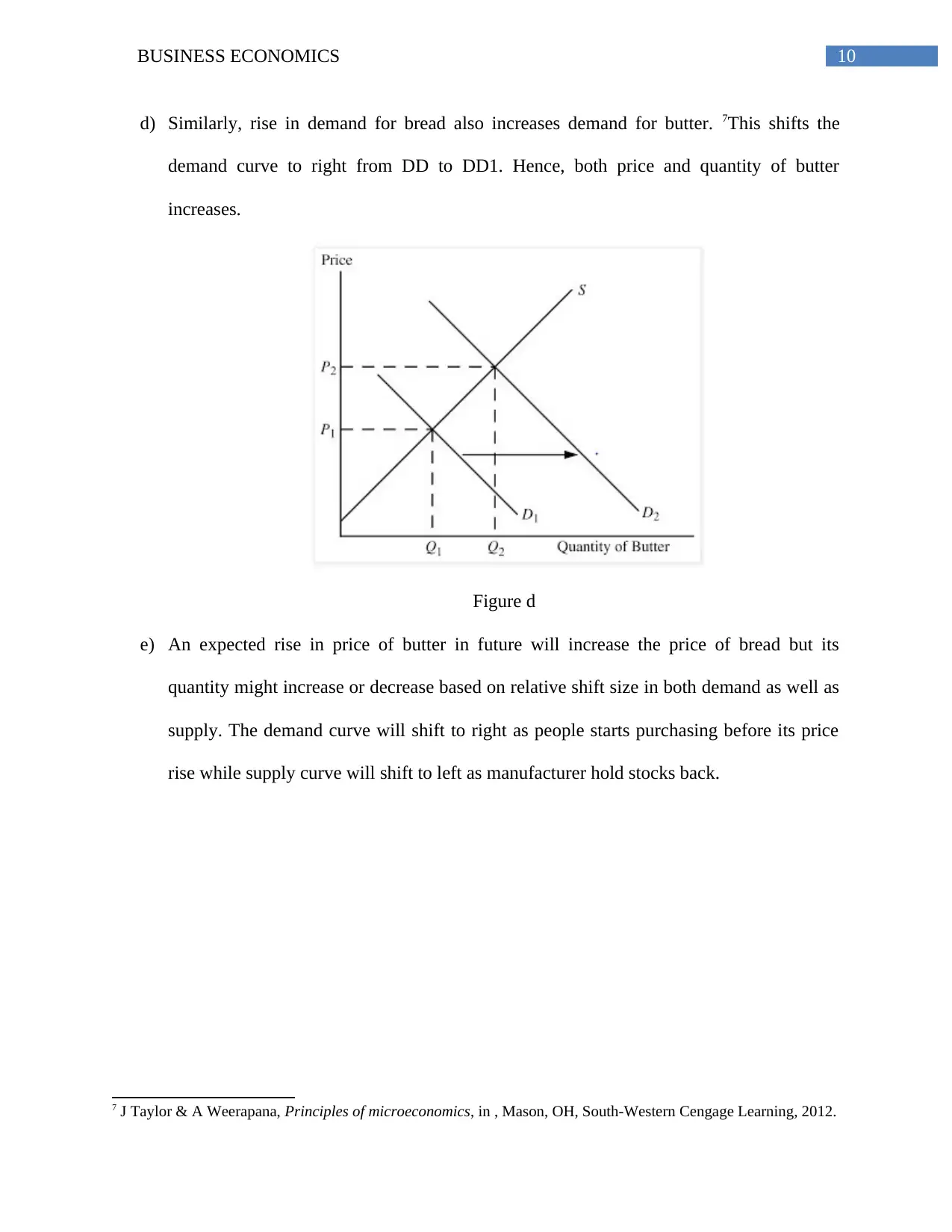
10BUSINESS ECONOMICS
d) Similarly, rise in demand for bread also increases demand for butter. 7This shifts the
demand curve to right from DD to DD1. Hence, both price and quantity of butter
increases.
Figure d
e) An expected rise in price of butter in future will increase the price of bread but its
quantity might increase or decrease based on relative shift size in both demand as well as
supply. The demand curve will shift to right as people starts purchasing before its price
rise while supply curve will shift to left as manufacturer hold stocks back.
7 J Taylor & A Weerapana, Principles of microeconomics, in , Mason, OH, South-Western Cengage Learning, 2012.
d) Similarly, rise in demand for bread also increases demand for butter. 7This shifts the
demand curve to right from DD to DD1. Hence, both price and quantity of butter
increases.
Figure d
e) An expected rise in price of butter in future will increase the price of bread but its
quantity might increase or decrease based on relative shift size in both demand as well as
supply. The demand curve will shift to right as people starts purchasing before its price
rise while supply curve will shift to left as manufacturer hold stocks back.
7 J Taylor & A Weerapana, Principles of microeconomics, in , Mason, OH, South-Western Cengage Learning, 2012.

11BUSINESS ECONOMICS
Quantity of butter
Price S
S1
D1
D
P1
P
Q Q1
Quantity of butter
Price
S
S1
D
P
Q
P1
Q1
Figure e
f) A tax on butter production shifts the supply cure to left and hence price of butter rises and
its quantity falls.
Figure f
g) 8If new process of removal of cholesterol from butter is invented, then the demand for
butter will increase and this will shift demand curve to right but the supply curve will
shift to left owing to rise in production cost. Hence, its price rises but quantity might
increase or decrease based on shifting size in both demand and supply.
8 K Case, R Fair & S Oster, Principles of microeconomics, in , Boston, Prentice Hall, 2012.
Quantity of butter
Price S
S1
D1
D
P1
P
Q Q1
Quantity of butter
Price
S
S1
D
P
Q
P1
Q1
Figure e
f) A tax on butter production shifts the supply cure to left and hence price of butter rises and
its quantity falls.
Figure f
g) 8If new process of removal of cholesterol from butter is invented, then the demand for
butter will increase and this will shift demand curve to right but the supply curve will
shift to left owing to rise in production cost. Hence, its price rises but quantity might
increase or decrease based on shifting size in both demand and supply.
8 K Case, R Fair & S Oster, Principles of microeconomics, in , Boston, Prentice Hall, 2012.
⊘ This is a preview!⊘
Do you want full access?
Subscribe today to unlock all pages.

Trusted by 1+ million students worldwide
1 out of 14
Related Documents
Your All-in-One AI-Powered Toolkit for Academic Success.
+13062052269
info@desklib.com
Available 24*7 on WhatsApp / Email
![[object Object]](/_next/static/media/star-bottom.7253800d.svg)
Unlock your academic potential
Copyright © 2020–2026 A2Z Services. All Rights Reserved. Developed and managed by ZUCOL.




